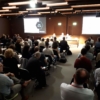Quale ruolo per gli innovation hub nello sviluppo di nuove forme di mobilità smart?
Laura Morgagni, Direttore di Torino Wireless, intervistata dalla giornalista Nathalie Croisé durante l’Imagine Mobility Forum del 7 giugno a Parigi.
Good morning Laura, today we talk about innovation hubs and the role they play to develop a new deal for efficient mobility. First of all, could you briefly describe your cluster?
Torino Wireless was established in 2003 as a wide public-private partnership with both National and Regional players to lead the first Italian high-tech cluster focused on ICT and to act as abridge among companies, research institute and policy makers to develop collaborative innovation projects.
Torino Wireless, nowadays, leads and coordinate two clusters: the Regional Innovation Cluster on ICT and the Italian Cluster for Smart Communities.
SmartCommunitiesTech is a national network to build and deploy innovative solutions for urban and societal challenges and with a special focus on smart & sustainable mobility. This network counts more than 160 companies and 40 Italian cities collaborating on Smart Cities & Communities projects, so far.
Along the journey Torino Wireless built a wide network of partners at European and international level as well, with whom we are currently developing R&D projects, benchmarking and experience sharing activities, SMEs promotion on foreign markets.
Within its institutional role, besides, Torino Wireless, supports local stakeholders and public administrations to develop digital innovation projects and has a special expertise in managing complex Smart City projects: Torino City Council appointed Torino Wireless to coordinate the City Master Plan design project that delivered, in just six months, the SMILE Master Plan and lead Torino along the smart city path.
What role do Innovation Hubs play to support mobility?
Either you think at smart and sustainable mobility within urban context or at innovative paradigm like MAAS or at visionary scenario like Autonomous Driving, you cannot forget that all these goals could be achieved only by supporting effective public-private partnerships on one side and wide industrial collaborations on the other side.
The most relevant factor will be getting all the players to work together: reality in this type of services requires building a multi stakeholder consortium of players. This is not just government’s responsibility – the private sector has also an important role to play.
What are the key factor enabling this kind of collaboration?
In our experience, collaboration with the municipality is overall harder if you put private players in the middle, that could be felt as “no neutral” players. To manage this complexity, a step forward must be taken.
First, cities must have a very strong vision in mind and that vision must be widely accepted within the municipality and widely shared outside the municipality. Besides, Governments should set the metrics by which success is measured. Hopefully, Cities and Governments must promote data accessibility and municipalities should create an open architecture that private partners cat integrate to, but still meets the need of citizens.
In addition, both City Council and its offices must set up collaborative approaches (also aligned with agile development concepts, that could be very helpful), and this is possible only if a very strong sponsor is available: typically, directly the city major or a “Innovation” Assessor that could lead the process and easier find the necessary funding as well
Finally, Cities must rely on third parties: the capital and innovation capabilities of the private sector are essential and Innovation hubs can be helpful in managing relationship with private players in a fair and effective way.
And how this model of collaboration can be sustainable?
Well, considering that, while none can innovate alone, but competences, ideas, resources and execution capabilities can come from several different actors and public-private partnerships are necessary, crucial is the possibility to define and then run sustainable business models, that can pay back the private investment. This means that Cities must be prepared to ensure long-term vision and clear «contracts» to sustain private investments that can show a clear return for companies involved, and this is a very big issue.
Thus, Innovation Hubs could help investigating success stories and putting most relevant players in touch to share experiences and opportunities, besides they can add competencies and capacities to the system and can support by looking for the right private players to collaborate with.
Do we still have to talk about “greener, safer and smarter” mobility or today buzzwords are more “user-centric, inclusive and efficient” mobility inclusive?
Both, the two subjects are related, one serves and complements the other: by including citizens allowing them to be the center of the mobility services and needs, improves the safety of a city, and the creation of awareness enhance the smartness and efficient decision-making processes and use of resources.
The World economic forum says in their key trends making our cities greener, safer and smarter report that “To prepare for the future, we must create SMARTER cities with buildings and communities that incorporate highly efficient designs with advanced envelopes, lighting, heating and cooling equipment, the use of renewable or distributed energy resources, the addition of battery electric/thermal storage and the ability to safely “island” operations from the power grid. These cities will accelerate the industry trend towards net zero energy when their buildings and communities produce more energy than they consume from the grid over the course of a year. These cities will also be able to provide their residents with critical services during emergencies including food, water, shelter, the refrigeration of medical supplies and the charging of medical instruments.”



